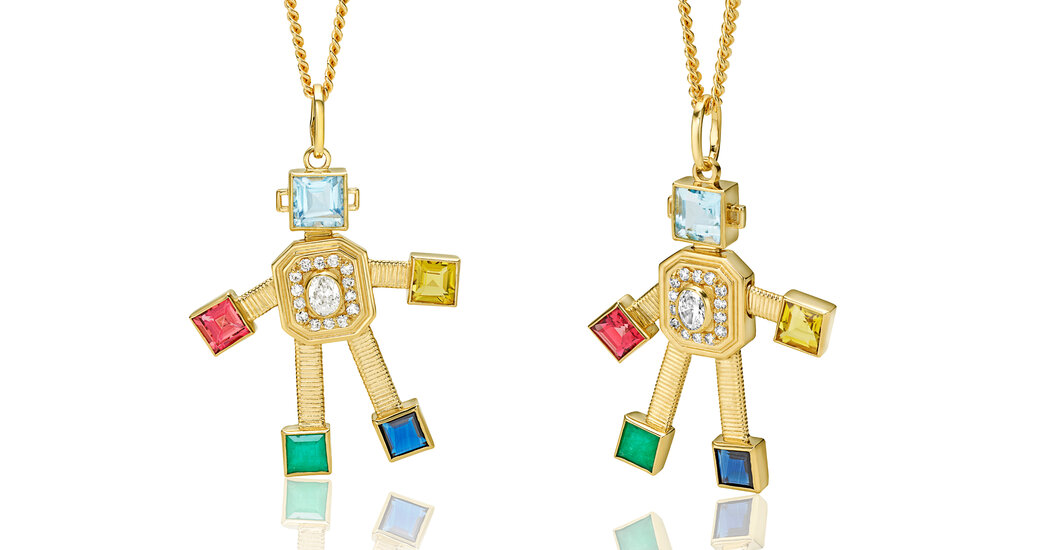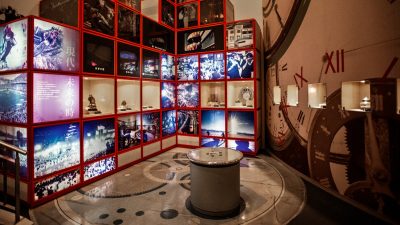When the French jewelry designer Marie Lichtenberg was growing up in Paris in the 1990s, she loved playing with the Magic 8 Ball. The toy, when shaken, acts as a kind of fortuneteller, revealing answers to questions in a small window: “Don’t count on it.” “It is certain.” “Ask again later.”
“My parents traveled a lot,” Ms. Lichtenberg said on a phone call from her home in Paris. “Each time they went to the U.S., they brought back some goodies for me and my siblings, and the Magic 8 Ball was one of them.
“I still have this ball, and my daughter and little boy are playing with it,” she added.
Last summer, Ms. Lichtenberg was sitting on her couch, thinking about what to design next, when she noticed the ball on her coffee table. “I know what we have to do,” she remembered thinking. “We have to make the 8 Ball in gold and diamonds!”
In June, at the Couture jewelry show in Las Vegas, the designer presented an 18-karat gold, diamond and enamel version of the $10 plastic toy, but with a price of $21,560. The pendant — which replicates the original 8 Ball’s fortunetelling functionality and was crafted in Italy with the blessing of Mattel, the toy’s manufacturer — earned the show’s Best in Innovative award. (The judges applauded “its ability to spark joy.”)
When Ms. Lichtenberg decided to remake the Magic 8 Ball, she didn’t even know that Mattel, the maker of Barbie, owned the rights. Instead, she was operating on the same instinct that appears to be motivating some jewelers: chiefly, the desire to create designs that conjure the playfulness of their childhoods.
As a result, a tide of fine jewels inspired by such things as unicorns and the Rubik’s Cube are coming to market.
Camille Zarsky, founder of the Seven, a designer jewelry boutique in Manhattan’s West Village, interpreted the trend as evidence of a collective desire for “lighthearted distractions.”
“People are looking for things that are less serious and more whimsical,” Ms. Zarsky said in a phone interview from Sag Harbor, N.Y., where the Seven had just opened a location, its second.
In 2020, during a pandemic lockdown, Claire Choisne, the creative director of the Paris-based jeweler Boucheron, came to a similar conclusion.
“Two days before our trip with my team in Africa, we had to cancel it,” Ms. Choisne wrote in an email. “Everyone was sad! We went on Pinterest and spent hours looking for inspiration. Through this process, I found pictures of Memphis Design that reminded me of a happy time during my childhood in the ’80s.”
She was referring to the bright colors, geometric shapes and bold patterns of the Memphis Design movement, a style associated with a group of Italian architects and designers who dominated the decade with their Pop Art-inspired sensibilities.
The result was Boucheron’s 30-piece More is More collection, introduced in July during Couture Week in Paris, widely praised on social media for its ingenuity and humor. Among the line’s many talking pieces was the Solve Me necklace, essentially, a deconstructed Rubik’s Cube studded with precious stones.
“Like the cubes of the original puzzle, every facet of the piece has a different color,” Ms. Choisne wrote. “The craftsmen set gray spinels and pink sapphires onto little white gold plates before inserting each one into an aluminum cube. Various types of mother-of-pearl were used: white, pink and gray.”
Ms. Choisne echoed many fine jewelers when she cited the pursuit of happiness as the motivating factor in her design process.
“At that time, the most precious thing for me was joy,” she wrote. “I could not take any more constraints, I felt like a rebel, and I wanted my team and I to design whatever made us happy, expressing whatever we wished to express. I needed colors, playfulness.”
Emily P. Wheeler, a fine jewelry designer based in Los Angeles, embraced the same mind-set. In May, she introduced a Mother’s Day capsule collection of Mommy and Me pieces created in collaboration with Maria Dueñas Jacobs, founder of the children’s jewelry brand Super Smalls.
In Ms. Wheeler’s gem-studded take, she remained faithful to the oversized scale of Super Smalls’s rainbow, glittery designs, but opted for precious materials. For example, Ms. Wheeler reinterpreted a $36 Super Smalls unicorn pendant made in base metals with imitation stones into a white agate design, with an 18-karat gold mane set with sapphires and rubies, on a necklace of white freshwater pearls.
“I’ve always felt there was something especially glamorous about having effortless style and not taking yourself too seriously,” Ms. Wheeler said.
She certainly lives by that credo. In 2019, long before “Barbie” became a blockbuster film, Ms. Wheeler had a hot pink vinyl wrap placed on her Land Rover Defender. “It looked like a giant toy car,” she said. “It was so funny and so fabulous.”
Ms. Wheeler framed her automotive choice as an example of how silliness can feel like an antidote to current events. “There’s a lot more seriousness that hangs over every decision we make today,” she said. “Whether to procreate, where to live. Is it ethical? Is this place going to be underwater in 20 years?”
But using pink cars — or jewelry — to lighten the mood is hardly a new phenomenon.
In 2012, Alison Chemla, creative director and designer of Alison Lou, founded her New York-based fine jewelry brand with a collection of seven emoji-inspired designs that celebrated “a new way of communicating,” Ms. Chemla said.
Four years later, the toy company Hasbro proposed that she turn a trio of its most classic products — the Twister and Monopoly games and Mr. Potato Head — into jewelry.
“Because I build out faces, Mr. Potato Head really resonated with me,” Ms. Chemla said. “I replicated the Twister board, with the spinning wheel, as a pendant.”
Tatiana Van Lancker, a London-based interior and product designer, drew on similarly nostalgic themes in 2019 when she introduced a line of gold and colored stone robot jewels based on an articulated pendant that her mother wore when Ms. Van Lancker was growing up in Sydney, Australia.
Designed to evoke the retro-futuristic vibe of Rosey the Robot, the maid on the 1960s animated sitcom “The Jetsons,” Ms. Van Lancker’s line of robot pieces, called Van, caught on when she wore a prototype to a party in London and sparked the interest of a fashion editor.
“They are absolutely meant to be your friendly bot,” Ms. Van Lancker said on a call from her home in Rome, where she and her husband relocated in 2022 for his work, putting her even closer to her workshop in Tuscany.
“My clients never take them off,” she added. “And because they’ve got this tactile element of being articulated, it becomes soothing. It feels like your little friend around your neck.”
Bella Neyman, the co-founder of NYC Jewelry Week and a frequent lecturer on jewelry history, said that in addition to evoking a more carefree time, toy-inspired jewels also served to “elevate the everyday by dressing it up in precious stones and metals.”
She cited the contemporary studio jewelers Emiko Oye, Margaux Lange and Lisa Walker as pioneers in the category.
“Margaux was using Barbies in her designs way before the movie was a thing,” Ms. Neyman said on a recent call. “Emiko has been sourcing vintage Legos. It’s also about upcycling and taking these things that are mass market and elevating them.”
In describing the work of Ms. Walker — “Her thing is about subversion, and surrealism” — Ms. Neyman mentioned Elsa Schiaparelli, the 20th-century Italian designer whose collaborations yielded fantastical jewels like the Aspirin necklace of blue porcelain beads that looked like the pain relievers, created with the novelist Elsa Triolet; and Ruby Lips, a brooch of a mouth with pearl teeth and lips of rubies, created with Salvador Dalí.
Ms. Zarsky of the Seven also alluded to the influence Schiaparelli still had on jewelry. “People want jewelry to be more than just diamonds and gold,” she said. “It’s about the storytelling, the escapism.”
Ms. Lichtenberg said there was one thing designers in this sector must remember: “The more unserious you get, the more you have to be super serious about your production. The craftsmanship needs to be to die for. Otherwise, it’s only a toy.”
Sumber: www.nytimes.com










